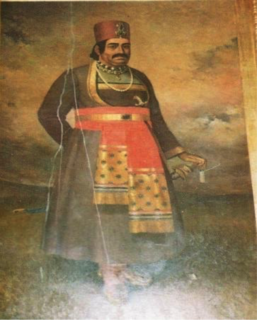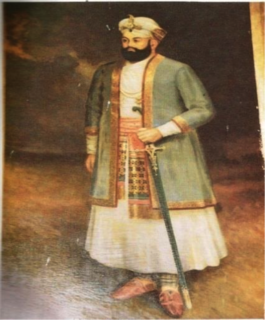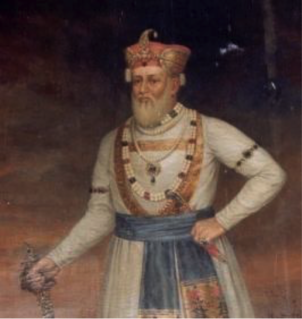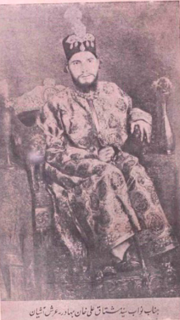 W
WNawab Ahmad Ali Khan Bahadur was Nawab of Rampur from 1794 to 1840, succeeding his brother Ghulam Muhammad Khan Bahadur. The only son of Muhammad Ali Khan Bahadur, Ahmad Ali was made Nawab following the deposition of his cousin Ghulam Muhammad by the British East India Company and the Nawab of Awadh. Ahmad Ali ruled for 46 years, although he reigned from 1794–1811 under a regency. He transformed the cultural fabric of Rampur and started a tradition of cultural involvement that has been maintained by his successors to the present day. In 1801, Rampur became a vassal of the HEIC following the cession of Rohilkand by the Nawab of Awadh. Ahmad Ali died on 5 July 1840, aged 52. As his only son had died young, he was succeeded as Nawab by his cousin, Muhammad Said Khan Bahadur.
 W
WAl-Haj Nawab Ghulam Muhammad Khan Bahadur was briefly Nawab of Rampur from 1793 to 1794. The younger son of Faizullah Khan, Ghulam Muhammad became Nawab in 1793 after deposing his elder brother, Muhammad Ali Khan Bahadur. His reign quickly took on a tyrannical aspect, and he was soon deemed a danger to the region's stability. Thus, in 1794, he was himself deposed by troops of the East India Company and of the Nawab of Awadh, being succeeded as Nawab by his nephew, Ahmad Ali Khan Bahadur. Ghulam Muhammad then undertook the Hajj, after which he fled to Mysore and Tipu Sultan, later settling in the Punjab. He died at Nadaun in 1828.
 W
WNawab Sayyid Hamid Ali Khan Bahadur was Nawab of the princely state of Rampur from 1889 to 1930.
 W
WHajji Nawab Kalb Ali Khan Bahadur was a Nawab of the princely state of Rampur from 1865 to 1887. Succeeding his father, Sir Nawab Yusef Ali Khan Bahadur, he continued his father's good works, expanding the Rampur library, constructing the Jama Masjid costing Rs.3 lakhs and encouraging the spread of education, irrigation, architecture, literature and art in general. A gifted ruler, Sir Kalb Ali Khan was highly literate in Arabic and Persian and patronised scholars from across India and the Islamic world. He was a member of John Lawrence's governance council from 1878 to his death, attended the Delhi Durbar of Queen Victoria and was granted a personal salute of 17-guns. He was succeeded at his death in 1887, aged 55, by his son, Muhammad Mushtaq Ali Khan Bahadur.
 W
WNawab Muhammad Yusef Ali Khan Bahadur, KSI, was a Nawab of the princely state of Rampur from 1855 to 1865. During the First War of Independence, he rendered many useful services to the Government of India by keeping the British supply and communication lines to Naini Tal open, rescuing fugitives and securing the town of Moradabad. For his service, he was granted extensive lands in Bareilly by the Viceroy of India, Lord Canning, was knighted in 1861 and given a 13-gun salute along with the style of His Highness. Finally, he was made a member of the Viceroy's Council. Despite this multitude of honours, Sir Yusef continued to preserve the Mughal artistic tradition by inviting musicians, scholars and artists of Bahadur Shah Zafar II's court to resettle at Rampur, including the great poet Ghalib. Dying at 49 in 1865, he was succeeded by his son, Sir Kalb Ali Khan Bahadur.
 W
WNawab Sayyid Faizullah Ali Khan was the first Nawab of Rampur. The princely state of Rampur was set up in year 1774, after the First Rohilla War, by the dismemberment of the Rohilla Kingdom of Rohilkhand. Faizullah Khan, the only surviving heir of Ali Mohammed Khan and opponent of the forces of Awadh and the British East India Company in the war, was installed as ruler of what was the newly created Rampur State. It bordered the Maratha Empire to the south, making it a strategic point. Under tutelage of the East India Company, Faizullah Khan ruled peacefully for 20 years. The capital Rampur was founded, and the Raza Library collection gathered.
 W
WNawab Muhammad Ali Khan Bahadur was the eldest son of Faizullah Khan and briefly Nawab of Rampur between 24 July and 11 August 1793 when he was deposed by his younger brother Ghulam Muhammad Khan Bahadur and exiled to Dungarpur. He died there a year later as a prisoner when he was shot in his sleep. His only son, Ahmad Ali Khan Bahadur, later became Nawab of Rampur.
 W
WNawab Muhammad Mushtaq Ali Khan Bahadur, was a Nawab of the princely state of Rampur from 1887 to 1889, succeeding his father Sir Nawab Kalb Ali Khan Bahadur. Owing to continued ill-health, he was unable to properly rule and govern the state and so left its affairs in the hand of an administrative council. However, he was successful in continuing the beneficiaries of his predecessors, particularly in the areas of agriculture and irrigation. He died at the age of 32 in 1889 and was succeeded by his son, Sir Hamid Ali Khan Bahadur.
 W
WNawab Muhammad Said Khan Bahadur was Nawab of Rampur from 1840 to 1855, succeeding his cousin Ahmad Ali Khan Bahadur. The son of Ghulam Muhammad Khan Bahadur, Muhammad Said spent his early years in the service of the East India Company, eventually rising to the rank of Deputy Collector for Dudain. Although his father had been a tyrant during his brief reign, Muhammad Said by contrast proved to be a benevolent and progressive ruler, building irrigation works and establishing courts of law and an advanced legal code. Muhammad Said died on 1 April 1855 in his 69th year and was buried at Rampur. He was succeeded by his eldest son, Yusef Ali Khan Bahadur.
 W
WSir Raza Ali Khan Bahadur GCIE, KCSI was a nawab of the princely state of Rampur from 1930 to 1966. A tolerant and progressive ruler, Sir Raza expanded the number of Hindus in his government Including his Prime Minister Lt.Col. Horilal Varma Bar At Law and, expanded the irrigation system, completed electrification projects and continued building schools, roads and sewage systems. Also patriotic, the Nawab sent his soldiers to fight in the Middle Eastern theatres of the Second World War. Acceding to the Union of India on 15 August 1947, Rampur was formally merged with it in 1949 and with the new state of Uttar Pradesh in 1950. Afterwards, Sir Raza devoted himself to charitable projects and to his post as head of the Freemasons in India as the first Grand Master of the Grand Lodge of India.